
Carnosauria is an extinct group of carnivorous theropod dinosaurs that lived during the Jurassic and Cretaceous periods.

Tetanurae is a clade that includes most theropod dinosaurs, including megalosauroids, allosauroids, tyrannosauroids, ornithomimosaurs, compsognathids and maniraptorans. Tetanurans are defined as all theropods more closely related to modern birds than to Ceratosaurus and contain the majority of predatory dinosaur diversity. Tetanurae likely diverged from its sister group, Ceratosauria, during the late Triassic. Tetanurae first appeared in the fossil record by the Early Jurassic about 190 mya and by the Middle Jurassic had become globally distributed.
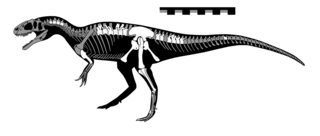
Gasosaurus is a genus of tetanuran theropod that lived approximately 171.6 to 161.2 million years ago during the middle of the Jurassic Period. The name "Gasosaurus" is derived from the English "gasoline" and the Greek σαῦρος. Only one species is currently recognised, G. constructus, from which the specific name honours the gasoline company that found the Dashanpu fossil quarry in Sichuan Province, China, now named as the Lower Shaximiao Formation.

Afrovenator is a genus of megalosaurid theropod dinosaur from the Middle or Late Jurassic Period on the Tiourarén Formation and maybe the Irhazer II Formation of the Niger Sahara region in northern Africa. Afrovenator represents the only properly identified Gondwanan megalosaur, with proposed material of the group present in the Late Jurassic on Tacuarembó Formation of Uruguay and the Tendaguru Formation of Tanzania.
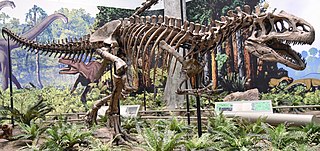
Allosauridae is a family of medium to large bipedal, carnivorous allosauroid theropod dinosaurs from the Late Jurassic. Allosauridae is a fairly old taxonomic group, having been first named by the American paleontologist Othniel Charles Marsh in 1878. Allosaurids are characterized by an astragalus with a restriction of the ascending process to the lateral part of the bone, a larger medial than lateral condyle, and a horizontal groove across the face of the condyles.

Megalosauridae is a monophyletic family of carnivorous theropod dinosaurs within the group Megalosauroidea. Appearing in the Middle Jurassic, megalosaurids were among the first major radiation of large theropod dinosaurs. They were a relatively primitive group of basal tetanurans containing two main subfamilies, Megalosaurinae and Afrovenatorinae, along with the basal genus Eustreptospondylus, an unresolved taxon which differs from both subfamilies.

Monolophosaurus is an extinct genus of tetanuran theropod dinosaur from the Middle Jurassic Shishugou Formation in what is now Xinjiang, China. It was named for the single crest on top of its skull. Monolophosaurus was a mid-sized theropod at about 5–5.5 metres (16–18 ft) long and weighed 475 kilograms (1,047 lb).

Piatnitzkysaurus is a genus of megalosauroid theropod dinosaur that lived approximately 179 to 177 million years ago during the lower part of the Jurassic Period in what is now Argentina. Piatnitzkysaurus was a moderately large, lightly built, bipedal, ground-dwelling carnivore that could grow up to 6.6 m (21.7 ft) long.

Megalosauroidea is a superfamily of tetanuran theropod dinosaurs that lived from the Middle Jurassic to the Late Cretaceous period. The group is defined as Megalosaurus bucklandii and all taxa sharing a more recent common ancestor with it than with Allosaurus fragilis or Passer domesticus. Members of the group include Spinosaurus, Megalosaurus, and Torvosaurus. They are possibly paraphyletic in nature with respect to Allosauroidea.

Xuanhanosaurus is a genus of theropod dinosaur that lived during the Middle Jurassic (Bathonian) of the Sichuan Basin, China, around 166 million years ago. This taxon represents one of the various non-coelurosaurian tetanuran taxa found on the Middle Jurassic of the region, uncovered in the Lower Shaximiao Formation. Although it has been known for more than 40 years, this taxon has been the subject of very few studies, although most seem to agree that it is a tetanuran, possibly a basal allosauroid, highlighting the fact that it has a vestigial fourth metacarpal.

Magnosaurus was a genus of theropod dinosaur from the Middle Jurassic of England. It is based on fragmentary remains and has often been confused with or included in Megalosaurus.

Condorraptor is an extinct genus of megalosauroid theropod dinosaur. Its genus name means 'robber from Cerro Condor', referencing a nearby village, while its species name, currumili, is named after Hipolito Currumil, the landowner and discoverer of the locality. It was among the earliest large South American theropods, having been found in Lower Jurassic strata of the Cañadón Asfalto Formation in the Cañadón Asfalto Basin of Argentina. The type species, described in 2005, is Condorraptor currumili. It is based on a tibia, with an associated partial skeleton that may belong to the same individual. Initially described as a basal tetanuran, Benson (2010) found it to be a piatnitzkysaurid megalosauroid and the sister taxon of Piatnitzkysaurus, a finding supported by later studies.

Dubreuillosaurus is a genus of carnivorous dinosaur from the middle Jurassic Period. It is a megalosaurid theropod. Its fossils were found in France. The only named species, Dubreuillosaurus valesdunensis, was originally described as a species of Poekilopleuron, Poekilopleuron? valesdunensis, which is still formally the type species of the genus. It was later renamed Dubreuillosaurus valesdunensis when, in 2005, Allain came to the conclusion that it was not part of the genus Poekilopleuron. Its type specimen, MNHN 1998-13, is only rivalled in the number of preserved elements in this group by that of Eustreptospondylus. Dubreuillosaurus is considered to be the sister species of Magnosaurus. It did not show signs of insular dwarfism even though it was uncovered on an island.

Kaijiangosaurus is a genus of carnivorous tetanuran theropod dinosaur from the Middle Jurassic of China. In 1984 He Xinlu named and described the type species Kaijiangosaurus lini. The generic name refers to the River (jiang) Kai. The specific name honours the paleontologist Lin Wenqiu.
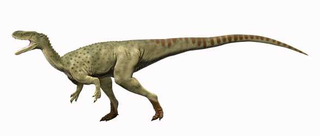
Spinostropheus is a genus of carnivorous neotheropod theropod dinosaur that lived in the Middle Jurassic period and has been found in the Tiouraren Formation, Niger. The type and only species is S. gautieri.
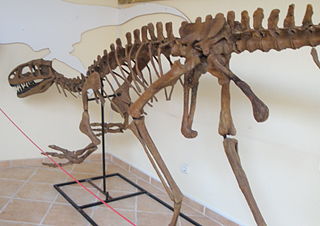
Lourinhanosaurus was a genus of carnivorous theropod dinosaur that lived during the Late Jurassic Period (Kimmeridgian/Tithonian) in Portugal. It is one of many large predators discovered at the Lourinhã Formation and probably competed with coeval Torvosaurus gurneyi, Allosaurus europaeus, and Ceratosaurus.

Poekilopleuron is a genus of tetanuran dinosaur, which lived during the middle Bathonian of the Jurassic, about 168 to 166 million years ago. The genus has been used under many different spelling variants, although only one, Poekilopleuron, is valid. The type species is P. bucklandii, named after William Buckland, and many junior synonyms of it have also been erected. Little material is currently known, as the holotype was destroyed in World War II, although many casts of the material still exist.
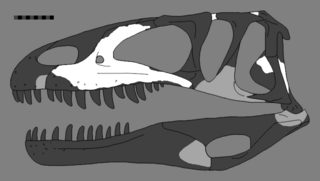
Leshansaurus is a genus of theropod dinosaur from the Late Jurassic Shaximiao Formation of what is now China. It was described in 2009 by a team of Chinese paleontologists. The type species is Leshansaurus qianweiensis. Fossils of Leshansaurus were discovered in strata from the Shangshaximiao Formation, a formation rich in dinosaur fossils. Li et al. referred this taxon to Sinraptoridae – a group of carnosaurian theropods, but it may belong to Megalosauridae instead.

Piatnitzkysauridae is an extinct family of megalosauroid or basal allosauroid dinosaurs. It only consists of three to four known dinosaur genera: Condorraptor, Marshosaurus, Piatnitzkysaurus and possibly Xuanhanosaurus. The most complete and well known member of this family is Piatnitzkysaurus, which also gives the family its name.

Orionides is a clade of tetanuran theropod dinosaurs from the Middle Jurassic to the Present. The clade includes most theropod dinosaurs, including birds.







































